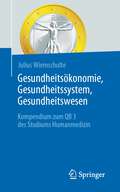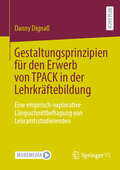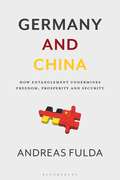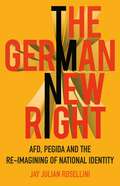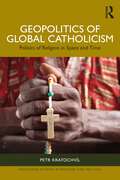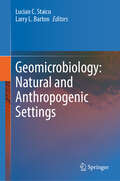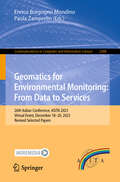- Table View
- List View
Gesundheitsökonomie, Gesundheitssystem, Gesundheitswesen: Kompendium zum QB 3 des Studiums Humanmedizin
by Julius WiemschulteIm Humanmedizinstudium ist der Querschnittsbereich 3 "Gesundheitsökonomie, Gesundheitssystem und Öffentliches Gesundheitswesen" ein verpflichtender Kurs im klinischen Studienabschnitt, der an allen medizinischen Fakultäten in Deutschland angeboten wird. In diesem Kurs erlernen die Studentinnen und Studenten die Systematik des Gesundheitswesens. Dieses Buch bietet in prägnanter Form die wichtigsten Informationen zum erfolgreichen Absolvieren des QB 3 und deckt die Themenfelder Gesundheitssystem, Öffentliches Gesundheitswesen, Gesundheitsökonomie und Qualitätsmanagement ab. Die klar strukturierten Inhalte werden durch praktische Bezüge zum ärztlichen Arbeitsalltag greifbar, so dass die große Relevanz des Stoffes als Rückgrat der ärztlichen Tätigkeit ersichtlich wird. Verständnisfragen zur Wissensreflektion und Fallbeispiele runden das Kompendium ab. Das Buch richtet sich an Studentinnen und Studenten der Humanmedizin und ist auch empfehlenswert für fachnahe Berufsgruppen (Sozialversicherungsfachangestellte, Gesundheits- und Pflegefachberufe).
Gestaltungsprinzipien für den Erwerb von TPACK in der Lehrkräftebildung: Eine empirisch-explorative Längsschnittbefragung von Lehramtsstudierenden
by Danny DignaßDie voranschreitende Digitalisierung unserer Lebenswelt stellt die traditionelle Lehrkräfteausbildung in Deutschland vor die Herausforderung, sich den Veränderungen anzupassen und den steigenden Anforderungen im Umgang mit digitalen Medien gerecht zu werden. Dieses Buch konzentriert sich auf die Entwicklung und Förderung von digitalisierungsbezogenen Kompetenzen und Einstellungen sowie der unterrichtlichen Nutzungshäufigkeit digitaler Medien bei Lehramtsstudierenden. Am konkreten Beispiel der Technischen Universität Dortmund werden dabei Zusammenhänge zwischen spezifischen Gestaltungsprinzipien digitalisierungsbezogener Lehr-Lernangebote für angehende Lehrkräfte und dem TPACK-Konzept erforscht. Die Untersuchung basiert auf einer umfassenden Auswertung quantitativer und qualitativer Daten aus den Sommersemestern 2021 und 2023. Im Zentrum dieser Arbeit steht die Bereitstellung einer evidenzbasierten Orientierung für die Vorbereitung von Lehramtsstudierenden auf einen effektiven Einsatz digitaler Medien in schulischen Lehr-Lernprozessen in der Digitalität.
Gestalt Therapy: The Basics (The Basics)
by Dave MannGestalt Therapy: The Basics provides an accessible and concise overview of the approach and its substantial theory.Experiential exercises, clinical vignettes and examples from everyday practice are included to enrich understanding of gestalt’s theory and its clinical application. This book explores: the history of gestalt therapy, gestalt maps, philosophical beliefs, creative experimentation and ethical considerations. Useful chapter summaries are featured throughout to aid comprehension.This book is essential reading for gestalt trainees, as well as counsellors and psychotherapists wanting to learn more about the gestalt approach.
Gestalt Therapy: The Basics (The Basics)
by Dave MannGestalt Therapy: The Basics provides an accessible and concise overview of the approach and its substantial theory.Experiential exercises, clinical vignettes and examples from everyday practice are included to enrich understanding of gestalt’s theory and its clinical application. This book explores: the history of gestalt therapy, gestalt maps, philosophical beliefs, creative experimentation and ethical considerations. Useful chapter summaries are featured throughout to aid comprehension.This book is essential reading for gestalt trainees, as well as counsellors and psychotherapists wanting to learn more about the gestalt approach.
Geschlecht und Materialität: Historische Perspektiven auf Erziehung, Bildung und Sozialisation von der Antike bis zur Gegenwart (Historische Geschlechterforschung #8)
by Ulrich Leitner Christina AntenhoferWelche Bedeutung hat Materialität für die Konstruktion von Geschlechterverhältnissen in Erziehungs-, Bildungs- und Sozialisationsprozessen? Die Beiträger*innen beantworten diese Frage aus interdisziplinärer Perspektive und loten die Beziehung zwischen Materialität und Geschlecht erziehungswissenschaftlich, ethnologisch, geschichtswissenschaftlich und kunsthistorisch aus. Dabei nehmen sie von antiken Ahnenmasken bis zu Körperobjekten im digitalen Spiel unterschiedliche Quellen in den Blick.
Germany’s French Allies 1941–45 (Men-at-Arms #556)
by Massimiliano AfieroA fully illustrated study of the Wehrmacht's French volunteer units and their actions on the Eastern Front and in North Africa during World War II.It is little known that, in late 1941, French volunteer units were among Wehrmacht troops defending Germany in the first bitter winter on the Eastern Front, and also among the last fighting for Berlin in April 1945. After Germany invaded the Soviet Union in June 1941, some 13,000 Frenchmen enlisted in the 'Légion des volontaires français contre le bolchévisme' (LVF), which was reformed as the Wehrmacht's Infanterie-Regiment 638 and posted to Russia.This volume examines the involvement of French volunteers, not only on the Eastern Front, but also in the 'Phalange Africaine' in Tunisia and in the 'Légion Tricolore', a short-lived military organization under the control of the French Vichy government. Using archive photographs and specially commissioned artwork, it casts a new light on forces fighting for the Axis and studies the French personnel's equipment, insignia and uniforms while describing their involvement in some of the most gruelling battles of World War II.
Germany’s French Allies 1941–45 (Men-at-Arms #556)
by Massimiliano AfieroA fully illustrated study of the Wehrmacht's French volunteer units and their actions on the Eastern Front and in North Africa during World War II.It is little known that, in late 1941, French volunteer units were among Wehrmacht troops defending Germany in the first bitter winter on the Eastern Front, and also among the last fighting for Berlin in April 1945. After Germany invaded the Soviet Union in June 1941, some 13,000 Frenchmen enlisted in the 'Légion des volontaires français contre le bolchévisme' (LVF), which was reformed as the Wehrmacht's Infanterie-Regiment 638 and posted to Russia.This volume examines the involvement of French volunteers, not only on the Eastern Front, but also in the 'Phalange Africaine' in Tunisia and in the 'Légion Tricolore', a short-lived military organization under the control of the French Vichy government. Using archive photographs and specially commissioned artwork, it casts a new light on forces fighting for the Axis and studies the French personnel's equipment, insignia and uniforms while describing their involvement in some of the most gruelling battles of World War II.
Germany and China: How Entanglement Undermines Freedom, Prosperity and Security
by Andreas FuldaAs Europe finds itself once again caught between two superpowers – the USA and a rising China – little has been written about a relationship that will have a profound influence on the international order: the relationship between the People's Republic of China and Germany. In Germany and China, leading international relations expert Andreas Fulda looks critically at the increasingly interdependent relationship between the two countries. Drawing on examples from politics, industry, development aid and technology sectors and academia, the book explores how successive governments from Helmut Kohl to Angela Merkel have pursued ever-closer ties to China in the interests of short term economic gain. Fulda explores the danger of this increasing entanglement not just for Germany, but for Europe and the international world order.
Germany and China: How Entanglement Undermines Freedom, Prosperity and Security
by Andreas FuldaAs Europe finds itself once again caught between two superpowers – the USA and a rising China – little has been written about a relationship that will have a profound influence on the international order: the relationship between the People's Republic of China and Germany. In Germany and China, leading international relations expert Andreas Fulda looks critically at the increasingly interdependent relationship between the two countries. Drawing on examples from politics, industry, development aid and technology sectors and academia, the book explores how successive governments from Helmut Kohl to Angela Merkel have pursued ever-closer ties to China in the interests of short term economic gain. Fulda explores the danger of this increasing entanglement not just for Germany, but for Europe and the international world order.
The German New Right: AfD, PEGIDA and the Re-Imagining of National Identity
by Jay Julian RoselliniContemporary Germany is a modern industrial democracy admired throughout the world. Many Germans believe that they live in the 'best Germany' that has ever existed. Yet there are dissenting voices: individuals and groups that reject cosmopolitanism, globalization and multiculturalism, and yearn for the more homogeneous country of earlier times. They are part of a global movement, often characterized as populist, that values tradition over innovation or constant change. In Germany, such people are routinely portrayed as reactionary or even neo- fascist. The present study seeks to provide a portrait of these individuals and their organizations. Very little has been written in English about the cultural figures who play a role in this movement. When the political side is discussed--whether in its manifestation as a party (the Alternative for Germany) or a citizens' group (PEGIDA)--the cultural dimension is usually ignored. Jay Julian Rosellini places the so-called New Right in the context of currents in German culture and history that differ from those in other countries. With Germany the dominant country in the European Union, economically and politically, this volume offers an essential view of its current conditions, future prospects and political particularities.
German Foreign Policy and Greek Martyr Communities: Reconciliation Policy for Places of Memory in Greece and the Role of Recognition
by Charalampos KarpouchtsisThe Euro crisis of 2008 had a deep impact on German-Greek relations. The exchange of blows in media, and amongst politicians created a deep divide and made old wounds visible - wounds that lie in the Occupation of Greece by Nazi Germany and its fascist allies during World War 2. In 2014 German foreign policy towards Greece shifted to include reconciliatory measures, marking the beginning of Germany's foreign policy of reconciliation. One area of focus is memory culture and the Greek martyr communities, meaning villages and towns that experienced extreme violence, destruction, and executions. Diving into these places of terror and memory, the book analyzes German foreign policy of reconciliation while providing a profound view onto history, diplomacy, and the widely unknown Greek memory landscape. It entails a thorough review of German-Greek relations, more than seven unique maps and 10 case studies, accompanied by photographs and over 35 interviews. It shows how foreign policy, conflict and reconciliation intertwine and how international affairs meet the local level of everyday citizens.
Geriatrics Models of Care: Bringing 'Best Practice' to an Aging America
by Heidi White Marie Boltz Michael L. Malone Jonny Macias TejadaFollowing the success of the previous edition, the second edition of Geriatrics Models of Care is the definitive resource for systems-based practice improvement for the care of older adults. Several new models of care have been published in the last eight years, new outcomes have emerged to better understand the impact of existing models, and with the rise of the Age-Friendly Health Systems movement, promoting organized efforts to prepare our health care settings for older individuals is of more importance than ever. The second edition is organized based on the practice setting along a continuum of care: hospital, transitions from hospital to home, outpatient settings, and the emergency department. This book also highlights long-term care models, which is an important part of the continuum of care for older Americans. Further, this edition features models that address the needs of vulnerable populations. This new section will describe a spectrum of programs for older adults who have Alzheimer’s disease or Parkinson’s disease. Other models describe best practices for older adults undergoing surgery or those who want to remain functioning independently in their home. A defining feature of this book is that each chapter follows a standard template: 1) the challenge which led to the model; 2) the patient population served; 3) core components of the intervention; 4) the role of interdisciplinary health professionals; 5) evidence to support the intervention; 6) lessons learned in the implementation and dissemination of the model; 7) implications for family caregivers, and communities (particularly underserved and diverse communities); and 8) how each model will provide care across the continuum during an entire episode of care. In addition, each chapter features a “call out” box with practical tips for implementing the model.
Geriatric Rehabilitation: A Textbook for the Physical Therapist Assistant (Core Texts for PTA Education)
by Jennifer BottomleyAs the aging population continues to increase, so does the need for a text specific to the specialized care of the elderly patient as it applies to the physical therapist assistant student, faculty, and clinician. Geriatric Rehabilitation: A Textbook for the Physical Therapist Assistant, recognizes the growing role of the PTA in a variety of heath care settings from acute to home to long-term care settings, to name a few.Inside Geriatric Rehabilitation, Dr. Jennifer Bottomley, along with her contributors, focuses on the clinically relevant assessment, treatment, and management of the geriatric population. Pathological manifestations commonly seen in the elderly patient are addressed from a systems perspective, as well as a focus on what is seen clinically and how it affects function. Each pathological area covered includes: • Screening, assessment, and evaluation • Treatment prescription• Goal setting• Modification of treatment• Anticipated outcomes• Psychosocial, pharmacological, and nutritional elementsThe organization and presentation of the practical, hands-on components of interventions, assessments, and decision-making skills make this a go-to text for the PTA to administer comprehensive geriatric care at each point along the continuum of care.Some of the features inside include:• Emphasis on treatment interventions–techniques, tips, and options• Focus on how assessment tools and treatments are applied and modified to benefit the geriatric population, and what the expected outcomes are• Clear and outlined chapter objectives• User-friendly summary tables in the nutritional and pharmacology chapters• Pearls that highlight important chapter information• Appendices and study aidsGeriatric Rehabilitation: A Textbook for the Physical Therapist Assistant answers the call for a text that focuses on the management of geriatric patients across the spectrum of care for the PTA, from students to those practicing in geriatric populations.
Geriatric Rehabilitation: A Textbook for the Physical Therapist Assistant (Core Texts for PTA Education)
by Jennifer BottomleyAs the aging population continues to increase, so does the need for a text specific to the specialized care of the elderly patient as it applies to the physical therapist assistant student, faculty, and clinician. Geriatric Rehabilitation: A Textbook for the Physical Therapist Assistant, recognizes the growing role of the PTA in a variety of heath care settings from acute to home to long-term care settings, to name a few.Inside Geriatric Rehabilitation, Dr. Jennifer Bottomley, along with her contributors, focuses on the clinically relevant assessment, treatment, and management of the geriatric population. Pathological manifestations commonly seen in the elderly patient are addressed from a systems perspective, as well as a focus on what is seen clinically and how it affects function. Each pathological area covered includes: • Screening, assessment, and evaluation • Treatment prescription• Goal setting• Modification of treatment• Anticipated outcomes• Psychosocial, pharmacological, and nutritional elementsThe organization and presentation of the practical, hands-on components of interventions, assessments, and decision-making skills make this a go-to text for the PTA to administer comprehensive geriatric care at each point along the continuum of care.Some of the features inside include:• Emphasis on treatment interventions–techniques, tips, and options• Focus on how assessment tools and treatments are applied and modified to benefit the geriatric population, and what the expected outcomes are• Clear and outlined chapter objectives• User-friendly summary tables in the nutritional and pharmacology chapters• Pearls that highlight important chapter information• Appendices and study aidsGeriatric Rehabilitation: A Textbook for the Physical Therapist Assistant answers the call for a text that focuses on the management of geriatric patients across the spectrum of care for the PTA, from students to those practicing in geriatric populations.
The George Bell-Alphons Koechlin Correspondence: The German Church Struggle in an International Perspective, 1933-1954 (The Selected Letters and Papers of George Bell, Bishop of Chichester)
by Andrew Chandler Gerhard RingshausenGeorge Bell was one of the most significant British church leaders of the mid-20th century and in many ways he came to define the involvement of British church people with the issues which arose from the Third Reich. The George Bell-Alphons Koechlin Correspondence, 1933-54 presents the extensive correspondence between Bell and a leading Swiss pastor and President of the Basel Church Council, Alphons Koechlin. The letters of Bell and Koechlin make an important contribution to our understanding of ways in which the unfolding history of the Hitler regime was interpreted in an international context from its earliest months in 1933 to its final destruction in 1945. In presenting the letters, this book captures a sustained meeting of European minds, thinking together in the midst of a crisis that was altering the conventional perimeters of politics and religion, and by degrees changing the life of the whole European continent - and drawing British politics into its vortex.This volume provides for the first time all the letters exchanged between Bell and Koechlin in their original English, with full scholarly apparatus and connected material. It contributes valuably to the historiography of the Third Reich and develops our understanding of Nazism not simply as an episode in German history, but as a fundamental crisis in international politics, religion and society.
The George Bell-Alphons Koechlin Correspondence: The German Church Struggle in an International Perspective, 1933-1954 (The Selected Letters and Papers of George Bell, Bishop of Chichester)
by Gerhard Ringshausen and Andrew ChandlerGeorge Bell was one of the most significant British church leaders of the mid-20th century and in many ways he came to define the involvement of British church people with the issues which arose from the Third Reich. The George Bell-Alphons Koechlin Correspondence, 1933-54 presents the extensive correspondence between Bell and a leading Swiss pastor and President of the Basel Church Council, Alphons Koechlin. The letters of Bell and Koechlin make an important contribution to our understanding of ways in which the unfolding history of the Hitler regime was interpreted in an international context from its earliest months in 1933 to its final destruction in 1945. In presenting the letters, this book captures a sustained meeting of European minds, thinking together in the midst of a crisis that was altering the conventional perimeters of politics and religion, and by degrees changing the life of the whole European continent - and drawing British politics into its vortex.This volume provides for the first time all the letters exchanged between Bell and Koechlin in their original English, with full scholarly apparatus and connected material. It contributes valuably to the historiography of the Third Reich and develops our understanding of Nazism not simply as an episode in German history, but as a fundamental crisis in international politics, religion and society.
Geopolitics of Global Catholicism: Politics of Religion in Space and Time (Routledge Studies in Religion and Politics)
by Petr KratochvílGeopolitics of Global Catholicism uncovers the key trends in today’s Catholicism, providing an incisive analysis of its deep entanglement with national, regional, as well as global politics.This book offers an exciting exploration of five versions of local Catholicism(s) and sheds light on the various theo-political constellations that not only differ widely across these national contexts but also have global geopolitical consequences. It is built around a novel theoretical argument showing that Catholic geopolitics contains not only a spatial dimension (as classic geopolitical studies would have it) but also a temporal one. As a consequence, the Catholic role in the world cannot be simply understood as a result of the spatial expansion of the Church but rather as a result of the complex relationships between Catholicism and colonization, inculturation, backwardness, and modernization(s). To counter the lingering Eurocentrism of most studies of the Catholic Church, this book’s case studies explore Catholic geopolitics in five non-European contexts, focusing mainly on the Global South (plus the United States): Latin America (Brazil), North America (the United States), Asia (India and China), and Africa (the Democratic Republic of the Congo). These case studies also show that the successes and failures of Catholicism cannot be explained by a recourse to a single, top-down interpretation of Catholic geopolitics, but rather by exploring the various Catholic spatio-temporal constellations on the global, regional, and local levels. With the accelerating diversification of the Church and the growing role of the Global South, these local and regional influences gain further importance as they are likely to increasingly define the future of Catholicism.This book will be of utmost interest to scholars of International Relations, Religious Studies, Political Science, and Theology, as well as Geopolitics, especially to those studying the global rise of religion. Its accessible language will also appeal to the wider public beyond academia, especially those interested in global Christianity, as well as church leaders, and members of Catholic organizations.
Geopolitics of Global Catholicism: Politics of Religion in Space and Time (Routledge Studies in Religion and Politics)
by Petr KratochvílGeopolitics of Global Catholicism uncovers the key trends in today’s Catholicism, providing an incisive analysis of its deep entanglement with national, regional, as well as global politics.This book offers an exciting exploration of five versions of local Catholicism(s) and sheds light on the various theo-political constellations that not only differ widely across these national contexts but also have global geopolitical consequences. It is built around a novel theoretical argument showing that Catholic geopolitics contains not only a spatial dimension (as classic geopolitical studies would have it) but also a temporal one. As a consequence, the Catholic role in the world cannot be simply understood as a result of the spatial expansion of the Church but rather as a result of the complex relationships between Catholicism and colonization, inculturation, backwardness, and modernization(s). To counter the lingering Eurocentrism of most studies of the Catholic Church, this book’s case studies explore Catholic geopolitics in five non-European contexts, focusing mainly on the Global South (plus the United States): Latin America (Brazil), North America (the United States), Asia (India and China), and Africa (the Democratic Republic of the Congo). These case studies also show that the successes and failures of Catholicism cannot be explained by a recourse to a single, top-down interpretation of Catholic geopolitics, but rather by exploring the various Catholic spatio-temporal constellations on the global, regional, and local levels. With the accelerating diversification of the Church and the growing role of the Global South, these local and regional influences gain further importance as they are likely to increasingly define the future of Catholicism.This book will be of utmost interest to scholars of International Relations, Religious Studies, Political Science, and Theology, as well as Geopolitics, especially to those studying the global rise of religion. Its accessible language will also appeal to the wider public beyond academia, especially those interested in global Christianity, as well as church leaders, and members of Catholic organizations.
The Geopolitics of Culture: James Billington, the Library of Congress, and the Failed Quest for a New Russia (NIU Series in Slavic, East European, and Eurasian Studies)
by John Van OudenarenThrough the lens of James Billington and the institution he led as Librarian of Congress during a key period of US-Russian relations, The Geopolitics of Culture examines culture as a neglected area of US foreign policy. Billington advised presidents and members of Congress and mobilized the resources of the Library of Congress to promote reform in Russia. He believed that rather than preaching to the Russians, the United States should expose the rising generation of Russian leaders to what was best in America and encourage them to rediscover positive elements in pre-Bolshevik Russian culture.The Geopolitics of Culture is the first book to chronicle Billington's influence on US engagement with Russia as it transitioned from communism to democracy under Gorbachev and Yeltsin and back to authoritarianism under Yeltsin and Putin. Drawing on published and archival sources (including recently released papers) and interviews with current and retired Library of Congress staff members, John Van Oudenaren casts new light on this era.Billington's efforts led to a remarkable degree of cooperation between the Library of Congress and Russian cultural and political institutions. Yet these efforts ultimately failed as Putin turned back toward authoritarianism. The experience of the Library of Congress during this period nonetheless holds important lessons for today. Billington believed that a transition to democracy in Russia was essential if the United States was to head off the geopolitical nightmare of a Eurasia dominated by an alliance of hostile authoritarian powers. The "geopolitics of culture" thus remains a challenge for US foreign policy.
Geopolitics and Energy Diplomacy in the Caspian Region: Developments after the Downfall of the Soviet Union (Edition Politik #172)
by Yunis GurbanovCould the Caspian Region replace Russia's or the Persian Gulf's immense energy potential with their energy resources? Yunis Gurbanov explores the strategic importance of the region in post-USSR Eurasian policies of major global actors, namely China, the EU, the USA, and Russia, and examines Azerbaijan's, Kazakhstan's, and Turkmenistan's oil and gas resources as alternatives to conventional suppliers. He shows that the Caspian region's resources could serve as alternative energy sources on a global level, mitigating dependence on traditional suppliers and stabilizing energy prices.
Geomicrobiology: Natural and Anthropogenic Settings
by Larry L. Barton Lucian C. StaicuThis volume brings together leading international experts to offer a unique and timely perspective on geomicrobiology through their latest research and findings. Chapters address interactions of marine and freshwater microorganisms contributing to geochemical cycles, including biochemical mechanisms for mineralization and transformation of solid minerals and dissolved metals. In addition, the resilience and physiological elasticity of specific bacteria in extreme environments is discussed, such as mechanisms of metal homeostasis and electrochemistry involving extracellular electron flow. Further coverage includes resource recovery (metals, minerals) using microbial-driven processes and technologies, with the aim to contribute to a better understanding of microbial potential within the framework of circular economy. This book is designed for professionals and students, including environmental engineers, microbiologists, and individuals studying the interaction of bacteria with metals and minerals in the environment. It is also a resource for students in academic programs or short courses focused on bacterial diversity in the environment, systems of bacterial energetics, resource recovery, and bacterial activities in extreme or nutrient-stressed environments. .
Geomatics for Environmental Monitoring: 26th Italian Conference, ASITA 2023, Virtual Event, December 18–20, 2023, Revised Selected Papers (Communications in Computer and Information Science #2088)
by Paola Zamperlin Enrico Borgogno MondinoThis book constitutes the proceedings of the 26th Italian Conference on Geomatics for Environmental Monitoring: From Data to Services, ASITA 2023, which was held as a virtual event during December 18-20, 2023. The 19 full papers included in this book were carefully reviewed and selected from 42 submissions. They were organized in topical sections as follows: Natural hazards monitoring and modelling; technological services for territory planning and Management; methodological advancements in data analysis and processing.
The Geology of North Africa (Regional Geology Reviews)
by Ezzoura Errami Zakaria Hamimi Abdel-Rahman Fowler Moulley Charaf Chabou Nuri Fello Amara Masrouhi Rémi LeprêtreThis richly illustrated book reviews the geology, tectonics, sedimentary basins and strategic resources of North Africa in 21 chapters. Chapter 1 is a regional synthesis. Chapter 2 examines the deep crustal and upper mantle structure. Chapter 3 compares the West African Craton. Chapters 4,5,6,7 deal with Pan-African-, Variscan (Hercynian)- and Alpine-Belts. Precambrian Geology of Hoggar Shield, north Central Africa will be addressed in Chapter 8. The North African Neoproterozoic and Phanerozoic sedimentary basins are the topic of Chapter 9. Phanerozoic magmatism and geodynamic framework of North Africa are addressed in Chapter 10. Chapters 11,12 deal with petroleum geology and water resources. Important non-metallic- and metallic- ore deposits are presented in Chapter 13,14,15,16. Chapters 17,18 explore geothermal energy and other strategic resources. Chapters 19,20 discuss seismicity, seismotectonics and Neotectonics, and Advances of exploration geophysics in North Africa. The lasttwo chapters (20, 21) focus on meteoric impact craters, geoheritage, geoparks and geotourism in North Africa.
Geography of Time, Place, Movement and Networks, Volume 5: Mapping Women and Family Journeys
by Stanley D. BrunnThis book investigates both early as well as recent accounts of journeys by women and families in African, Asian, East European, North and Latin American contexts. It discusses how places, place settings and transport routes, whether by land, sea, or air, were and remain important in the impacts these newcomers have on states and regions. The contributions to this book provide insight in laws and regulations related to women’s and refugees’ rights. They highlight the importance of place and location in defining rights and implementing reforms, such as the importance of the politics and the state in identifying rights in global contexts of refugee resettlement, cross-border employment, security and reshaping human institutions as well as the changing legal landscape related to for instance women participating in the Olympic Games and in national sports. The book also touches on the worlds of family landscapes, mapping family trees, family cemeteries and redefining immigrant city mixes. As such, the book offers readers to explore past, present, and future issues faced by women and families, regardless of place or country.
Geography of Time, Place, Movement and Networks, Volume 4: Mapping Time Transport Journeys
by Stanley D. BrunnThis book provides insight into the importance of place and place settings in personal journeys. It explores the worlds of time journeys in different contexts: daily work, community livelihoods, rural-urban migration, disease outbreaks and controls, cruise ship tours, and isolated frontier settings. Besides this, the book also addresses the networks connecting rural and urban places, transcontinental highways and railroads, rural-urban migration and other innovative journeys such as gas station road maps and body maps. The chapters also discuss how eradicating diseases are time/place journeys as is moving from a distant isolated frontier to a metropolis. As such, this book is a must read for those interested in exploring the intersections in and between the humanities and social/policy sciences.
